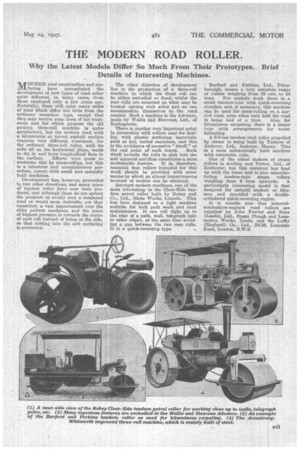• THE MODERN ROAD ROLLER.
Page 131

If you've noticed an error in this article please click here to report it so we can fix it.
Why the Latest Models Differ So Much From Their Prototypes. Brief Details of Interesting Machines.
lt/rODERN road construction and Bur-Ai-facing have necessitated the development of new types of road roller quite different, in many cases, from those employed only a few years ago. Naturally, there still exist many miles of road which differ but little from the ordinary macadam type, except that they may receive some form of tar treatment and for which purpose the old
• pattern three-roll machine is quite satisfactory, but the modern road with a bituminous or tarred asphalt surface requires very different treatment, for the ordinary three-roll roller, with its rolls all on the horizontal plane, tends to dig in and form longitudinal flats in
the surface. Efforts were made to ' overcome this by cross-rolling, but this is a laborious and unsatisfactory procedure, except with small and specially built machines.
Development has, however, proceeded in two other directions, and many types of tandem roller have now been produced, and although these do not spread the press-urn so evenly over a. cambered road as would seem desirable, yet they constitute a vast improvement over the older pattern machines, and the point of highest pressure is towards the centre of each roll iustead of being at the side, igo that cutting into the soft surfacing is prevented. The other direction of development lies in the production of a three-roll machine in which the front roll can be either swivelled or fixed, whilst the rear rolls are mounted on what may be termed sprung stub axles and so can accommodate themselves to the road camber. Such a machine is the Advance, made by Wallis and Steevens, Ltd., of Basingstoke.
There is another very important point in connection with rollers used for dealing with plastic surfacing materials, such as hot, tarred macadam, and this is the avoidance of excessive " dwell " at the end point of each travel. Such dwell permits the rolls to sink into the soft material and thus constitutes a most
undesirable feature. It is, therefore, essential that rollers intended for this work should be provided with some means by which an almost instantaneous reversal of motion can be obtained.
Amongst modern machines, one of the most interesting is the Clear-Side tandem petrol roller built by Robey and (Jo, Ltd., Globe Works, Lincoln. This has been designed as a light machine suitable for both path work and road maintenance. It can roll right up to the edge of a path, wall, telegraph pole or other object, at the same time avoiding a gap between the two rear rolls. It is a quick-reversing type. Barford and Perkins, Ltd., Peterborough, makes a very complete ranoof rollers weighing from ;38 cwt. to 16
tons. For asphalt work there is a small tandem-type with quick-reversing clutches, and, if necessary, this machine can be used for cross-rolling on a narrow road, even when only half the road is being laid at a time. Also, for bituminous carpeting, there is a larger type with arrangements for water ballasting.
A 6-S-ton tandem road roller propelled by steam is being built by Taskers of Andover, Ltd., Andover, Hants. This is a most substantially built machine with renewable rolls.
One of the oldest makers of steam rollers is Aveling and Porter, Ltd., of Rochester, but this company has kept up with the times and is also manufacturing tandem-type steam rollers weighing from 6 tons upwards. A. particularly interesting model is that designed for natural asphalt or bitumen and provided with a doublecylindered quick-reversing engine.
It is notable also that internal-combustion-engined road rollers are supplied by John Fowler and Sons (Leeds), Ltd., Steam Plough and Locomotive Works, Leeds, and the Laffly (England) Co., Ltd., 20-26, Lonsdale Road, London. N.W.6.




















































































































































































